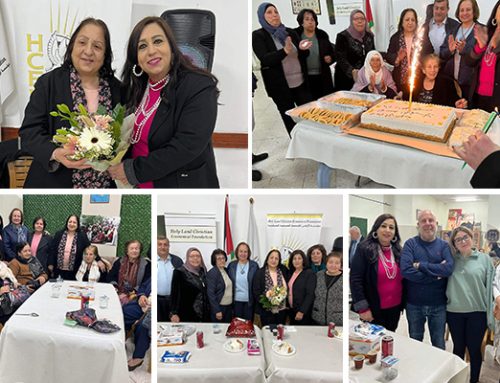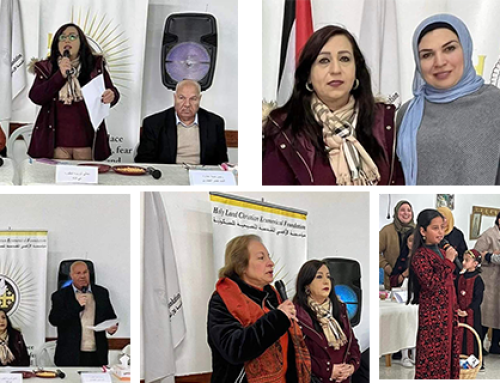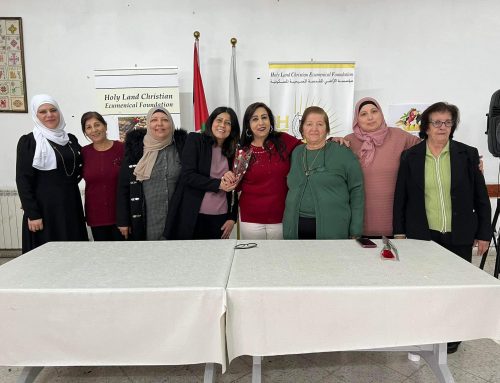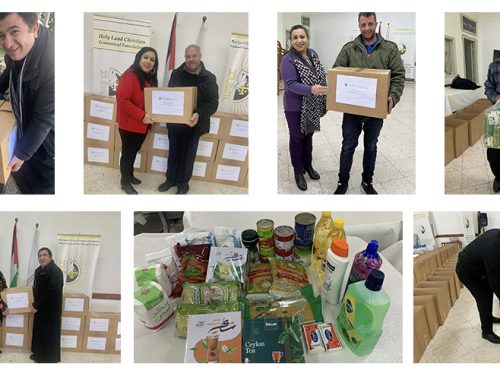The Holy Land enchanted me with its magnificent colors. In the Arab market of the old city of Jerusalem, bright quilts dazzled me with their diversity. Monochrome quilts could never convey the same brilliant beauty as these patchwork miracles of crimson, cerulean, emerald, orange, and amber. To remove a color or tear out stitches would be to severely limit the quilt. And yet the quilt of the Holy Land has been brutally ripped in two; countless threads have been broken and the master design has been damaged. A giant concrete wall separates Israeli from Palestinian, Jew from Arab. Spilled blood and fear separate their hearts. Repairing the quilt can seem a daunting and hopeless task. How does one start to heal lifetimes of pain? In early November, Fr. Jacek Orzechowski led a group of seventeen of us on a pilgrimage to the Holy Land to place our fingers in its wounds and walk in the footsteps of Christ. In the process, we witnessed unbearable sorrow and indescribable beauty; and in that beauty, we found the risen Christ and the key to hope.
That hope lay in the hands of countless people we met who, in the face of oppression and despair, work faithfully to tie the broken threads back together through peace and love. A transformative moment struck me at the Tent of Nations. Founded by the Nassar family, Palestinian Christians who have owned their land since 1916, the Tent of Nations uses nonviolent resistance and community building to protect their land from confiscation and build bridges of peace between diverse people. At the entrance to the Tent of Nations, a stone declares, “We refuse to be enemies.” While giving us a tour of the land, Daher Nassar told us how residents of a nearby Jewish settlement had come and ripped up 250 of their olive trees; soon after, a Jewish group from England visited and helped them plant 250 more olive trees in their place. Daoud Nassar’s wife told us how she invited a woman from the orthodox Jewish settlement over for lunch. The Jewish woman came, and later came back with a friend, telling “Daoud’s wife” that she was surprised to find that the Palestinians were real people with real families. Daher then told us that a week after our visit an entire group from the Jewish settlement was going to visit to pray with them. At the end of the tour, we climbed down into their chapel cave for a prayer service with Daher. While singing a song in Arabic and English that he taught us, I felt Christ incarnate in Daher and his family and in all of the people at Tent of Nations. I have never before experienced such beauty and such love, or such unfathomable power. Prayer by prayer, stitch by stitch, they are piecing the colors of the quilt back together.
We met many other faces of Christ as well. Two men from the Bereaved Parents Circle shared with us their tragic stories. Rami, an Israeli Jew, lost his daughter’s life to a suicide bomber; Mazan, a Palestinian, lost his father when he was gunned down by Israeli soldiers. Yet instead of seeking revenge and spreading hatred, they both meet regularly with other bereaved Israelis and Palestinians to pray and heal. The concrete wall that separates their people makes it difficult to meet, but they persevere. Rami said that the wall seems insurmountable, but person by person they are causing small cracks within that wall.
On Sunday, we had Mass at the local church in Birzeit. The Mass was in Arabic, but during the homily the priest took a moment to welcome us and speak to us in English. “When you return to your country,” he said (close paraphrase) “people will ask you what you saw here. Tell them you saw Christ. Tell them you saw Christ in the people, in the Palestinian Christians.” And I tell you now, resoundingly, yes, I saw the face of Christ. I saw Christ suffering today under systematic oppression and discrimination; I saw Christ weeping over violence and the death of loved ones; and I saw Christ resurrected in the faces of people of all faiths building bridges to each other through love and reconciliation. Finally, I saw Christ in the faces of my fellow pilgrims, each one astoundingly beautiful and uniquely gifted by God. As we gathered to pray and reflect on our experiences, our different ways of experiencing and comprehending God came forth; and through them, my own experience of God was infinitely enriched.
Thank you, Fr. Jacek and my fellow pilgrims for this profound experience.
-Hilary Meek
St. Camillus Church, Silver Spring, MD





